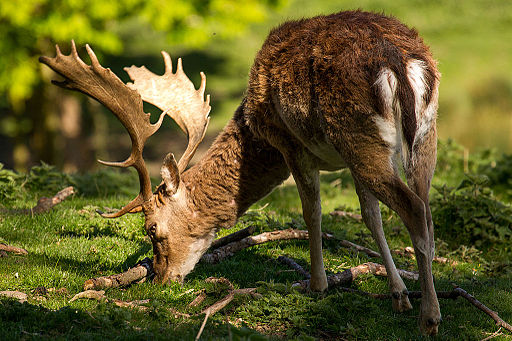How the Deer Got Blunt Teeth Chapter 3
“Let me see your teeth,” said Rabbit. “Ah, there isthere’s the problem, your teeth are long but not sharp like mine.” He twitchedtwitched his nose and openedopened his mouth to show Deer how long and sharp his teeth were.
“Let me your teeth and then you willyou'll easyeasily be able to chomp through vines and wood like I can,” said Rabbit. Deer noddednodded his head and agreed.agreed.
Rabbit pickedpicked up a hard, rough stone and Deer croucheded down on the ground and opened his mouth wide.
But instead of Deer’s teeth, Rabbit began to grind them down.
“Ow, Ouch!” cried Deer. “That hurts!”
“Stop making such a fuss! Sharpening your teeth always hurts,” said Rabbit. “Be brave, it will be worth it.”
Deer did notdidn’t complaincomplain again and Rabbit kept grinding down the teeth until they were blunt.
 Photograph by Michael Palmer“Ah, they arethey’re perfect now!” said Rabbit to Deer. “Try to bite through the grapevinegrapevine again.”again.”
Photograph by Michael Palmer“Ah, they arethey’re perfect now!” said Rabbit to Deer. “Try to bite through the grapevinegrapevine again.”again.”
Deer trytried, but this time he could notcouldn’t bite at all.
Rabbit laughed. "Now you have paid for your antlers," he shoutedshouted as he hoppedhopped away.away.
That is why to this day Deer’s teeth are blunt and he can only eat grass and leafleaves. But of course he does have a magnificentmagnificent pair of antlers!
|
Comprehension Summarise what has happened so far in this fable. Clarify these words: twitched, chomp, agreed, crouched, grind, complain, magnificent. Retell what has happened in this chapter. Make inferences about:
Predict what you think might happen next. What other ending could the fable have had? What question could you ask about this chapter? Visualise these uses of descriptive language: mottled light was filtering through the branches of the forest's ancient trees; pools of sunshine on the forest floor; musty smell of rotting leaves; green meadow, hidden in the middle of the forest; long slender legs, ending in tough black hooves; well-trodden paths; short muscly legs; thick tangled undergrowth. Make a connection with this narrative after each stage. What is the main idea or theme of this fable? What do you think the author is trying to tell us? |
Word Study Verb endings: What happens when we add s, ed or ing to: nod, agree, grind, bite, try, pay, hop, eat. Other affixes: What happens when we add other prefixes and suffixes like en, ly, s to these words: sharp, easy, leaf. What two words make up these compound words: grapevine, again. What two words are contracted here: there's, you'll, didn't, they're, couldn't. |